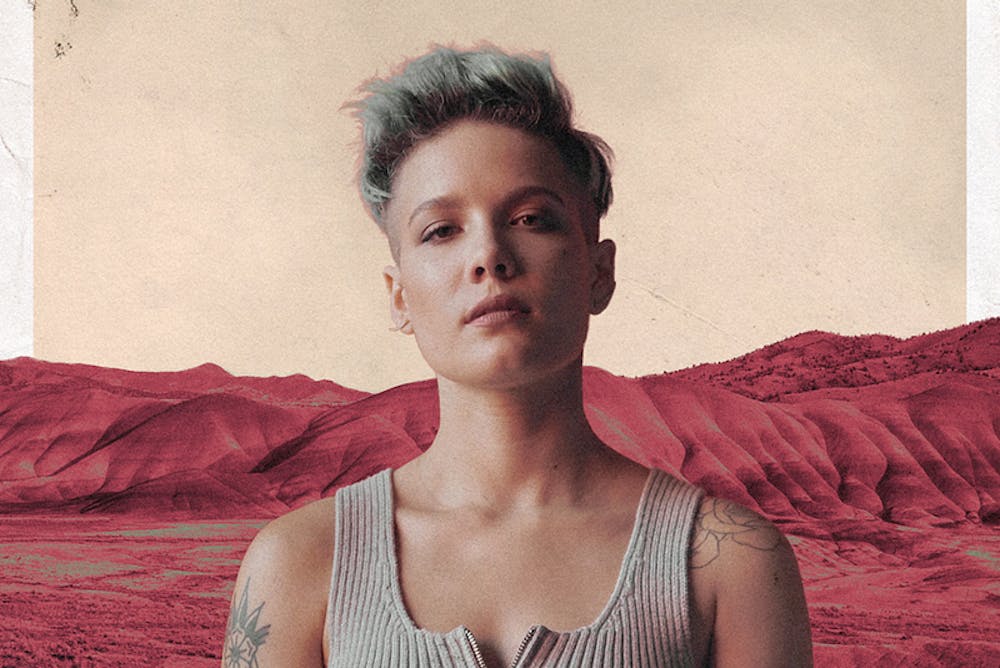Two weeks ago, Halsey (née Ashley Frangipane) revealed the cover art for her new album If I Can’t Have Love, I Want Power with an extravagant 13 minute YouTube video of the unveiling at the Metropolitan Museum of Art. In the video, Frangipane walks barefoot around the Met wearing a strange yet elegant get–up with her pregnant stomach prominently exposed, looking at paintings of the Virgin Mary. There is no music. Only the whooshing vacant sound of the air conditioning and traffic outside can be heard while she silently walks around the museum, ominously looking at the camera every so often.
At the end, she walks up to a red drape and yanks it down, unveiling at once ceremoniously and unceremoniously the cover art as a gigantic photograph in total silence. The cover art itself references a 15th–century painting of the Virgin Mary holding baby Jesus by Jean Fouquet, Frangipane’s breast proudly displayed. She wears a crown and holds a child in her arms, surrounded by a gold metallic sculpture that vaguely resembles long palm fronds or cobras rearing to attack their prey. To top it off, If I Can’t Have Love, I Want Power has an accompanying hour–long IMAX movie. The whole thing reeks of extravagance, a shrine to the cult of celebrity, or the investment of too much care into famous people.
Rihanna did something similar back in 2015 when she unveiled the cover art for ANTI at a private showing at the MAMA Gallery in Los Angeles. Like Halsey, she released no new music that night. In fact, she didn’t even mention the album. Unlike Halsey, however, Rihanna presented the artwork to a small crowd of viewers, all holding up their phones in hand as they clustered around the pop star. Although Rihanna’s cover art unveiling was a smaller affair, it generated just as much if not more buzz as Halsey’s. Everyone was ogling, either from Instagram and other social media or at the event itself, at the spectacle of self Rihanna put on. Both beg the question: Is there a way to appreciate their respective album artworks without buying into the cult of celebrity?
Rihanna’s artwork could be praised as “groundbreaking” for its incorporation of braille into the painting, effectively “[changing] the history of album art.” As for Halsey, the imagery in her album cover is distinctively medieval, harkening back to the time when monarchs and other royalty were painted large–scale for their own pleasure. After all, there’s a certain kind of narcissism in having yourself photographed like the Virgin Mary. Halsey isn’t the first celebrity to announce her pregnancy with lavish portraits, and she certainly won’t be the last. Nor is she the first to reference the Virgin Mary. It is venerable that she is glorifying “pregnant and postpartum bodies,” which are typically stigmatized and kept private away from the public eye.
Indeed, there seems to be a political and cultural agenda behind the lavish self–indulgence of her new album’s era. It’s plainly written in the album’s title itself: If I Can’t Have Love, I Want Power. That power is manifested as an extravagant portrait and accompanying IMAX film, as well as an album produced by none other than Trent Reznor and Atticus Ross of the legendary industrial rock band Nine Inch Nails.
Frangipane’s ambition is so big it can’t fail. Similarly, the braille poem, written by Chloe Mitchell, that bedecks Rihanna’s ANTI details what it’s like to be misunderstood by the world at large. “The world is pin drop sound compared to the boom / That thumps and bumps against the walls of my cranium.” ANTI, as an album and a title, is a blunt, all–caps, bisyllabic resistance against anything and everything. The prefix is meant both as an adjective and noun. It’s rebellion for rebellion’s sake because who the fuck is going to tell Robyn Rihanna Fenty otherwise? Frangipane is tapping into that punk egoism with her cover art, film, and new album. She’s usurping the trappings of the norm by replacing them with her own. Halsey is a queen, worthy of an exhibit at the Met—and your attention.

